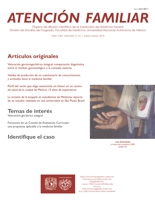Integral Gerontogeriatric Valuation: Diagnosis Comparison between the Gerontological Unit and External Consultation
Main Article Content
Abstract
Objetive: to compare between the Integral Gerontogeriatric Valuation (igv) and the traditional medical assistance. Material and methods: retrospective, comparative, observational and analytical study. Randomized sampling of 300 medical records of patients who were 60 or more years old and who attended the Gerontology Unit (group 1). A non-randomized sampling of 400 records of patients of Primary Care clinics (group 2). A collection card expressly designed was used. All variables were categorized as presence or absence of diagnosis and included those relating to the four areas: biological, psychological, social, and functional. Statistical analysis: χ2 homogeneity, significance level of 0.05. Statistical program spss 15. Results: some differences came up with statistical significance between the two groups in practically all the diagnostic of the four areas. At the moment of the analysis, according to the groups’ age, the very old and centenarians patients practically did not exist differences between diagnostic. Conclusions: differences in the diagnostic percentages make necessary to perform the igv at the first level of health care, since it is the first place where the largest number of elderly is concentrated and addressed.
Downloads
Download data is not yet available.
Article Details
How to Cite
González-Domínguez, R., Castillo-Feliciano, L. M., & González-Pedraza Avilés, A. (2013). Integral Gerontogeriatric Valuation: Diagnosis Comparison between the Gerontological Unit and External Consultation. Atención Familiar, 21(1). https://doi.org/10.22201/facmed.14058871p.2014.1.43580
